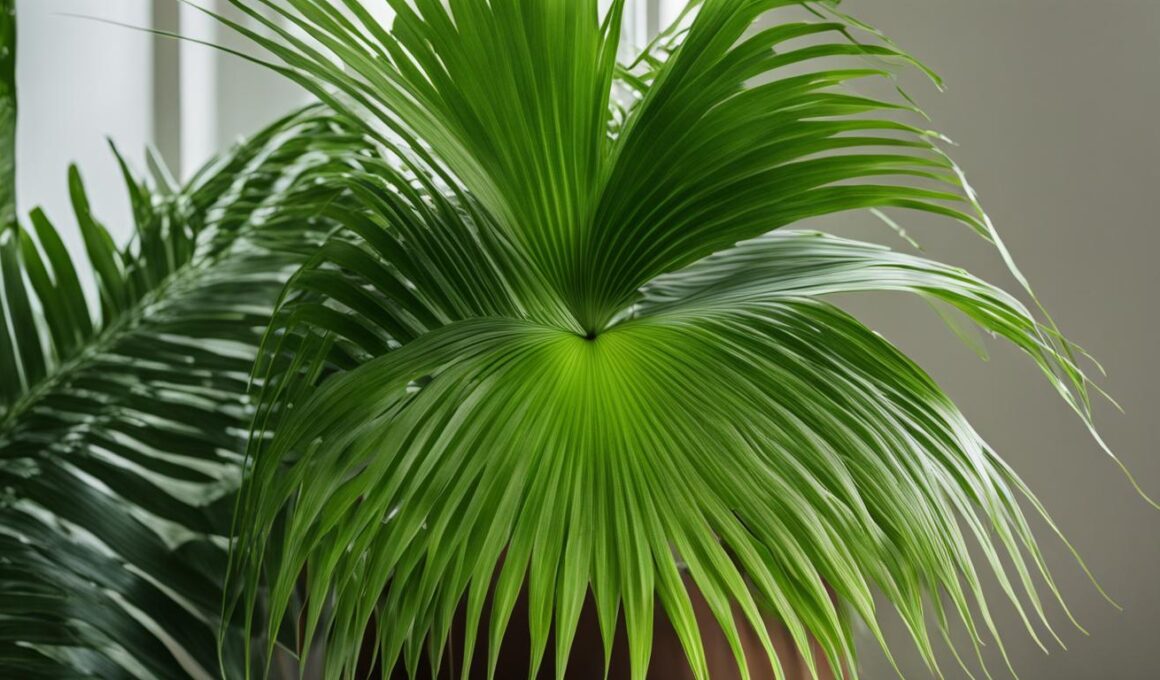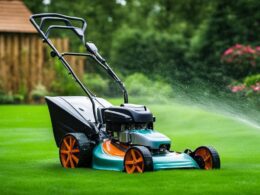Welcome to our Chinese Fan Palm Care Guide, where we’ll show you how to create a lush indoor oasis with these beautiful indoor palm plants. Not only do they add a touch of the tropics to your home, but they also act as natural air purifiers, improving the air quality of your living space. To ensure your Chinese Fan Palm and other indoor palm varieties thrive, it’s important to replicate their natural environment.
Chinese Fan Palms, like many indoor palm plants, are understory plants. This means they thrive in lower light conditions, making them suitable for areas in your home that don’t receive direct sunlight. Place your Chinese Fan Palm near a window that gets ample natural light, but avoid placing it in direct sunlight. This will ensure that it gets the right amount of light without getting scorched by intense rays.
Temperature and humidity are also important factors for indoor palm care. Chinese Fan Palms prefer warmer temperatures ranging from 60-85°F (15-29°C) during the day. At night, the temperature should not drop below 50°F (10°C). Most indoor palm plants, including Chinese Fan Palms, thrive in high humidity levels. You can increase the humidity around your palm by clustering plants together, using pebble trays, or using a humidifier.
Proper watering is crucial for the health of your Chinese Fan Palm. Overwatering can lead to root rot, while underwatering can cause the leaves to turn brown and dry. Always ensure that the soil is moist, but not waterlogged. Use well-draining soil, such as a mix of peat moss, perlite, and sand. Make sure the pot has good drainage to prevent water from pooling at the bottom.
Fertilizing is important to provide your indoor palm with the necessary nutrients. Use a slow-release fertilizer formulated for palm plants during the growing season. This will ensure steady nutrient supply without the risk of overfertilizing. Pruning should be limited to damaged or dead fronds. Avoid removing healthy green fronds as they are essential for photosynthesis.
Chinese Fan Palms are just one example of common indoor palm varieties. Other popular varieties include the Areca Palm, Lady Palm, Parlor Palm, and Kentia Palm. Each variety may have specific care requirements that should be considered. By following these care tips, you can create a thriving indoor oasis with a tropical ambiance, all while enjoying the benefits of air-purifying plants.
Specific Care for Common Indoor Palm Varieties
When it comes to caring for different indoor palm varieties, it’s important to understand their specific needs. Here, we’ll discuss the care requirements for some commonly found indoor palm plants:
Areca Palm (Dypsis lutescens)
The Areca Palm is an understory plant that thrives in lower light conditions. It prefers bright, indirect sunlight but can also handle direct morning sunlight. To ensure its health, it’s crucial to keep the soil evenly moist, allowing the top inch to dry out before watering. Overwatering can lead to root rot, so be mindful not to let the plant sit in standing water.
Lady Palm (Rhapis excelsa)
The Lady Palm is known for its elegant, fan-shaped leaves and adaptability to different light conditions. It can thrive in both bright, indirect light and lower light areas. It’s important to water the Lady Palm thoroughly and then allow the top inch of soil to dry out before watering again. This palm prefers evenly moist but not soggy soil. Regular misting can also help maintain proper humidity levels.
Parlor Palm (Chamaedorea elegans)
The Parlor Palm is another popular indoor palm variety that tolerates low light conditions. It can thrive in bright, indirect light as well as areas with minimal light exposure. It’s important to keep the soil consistently moist but avoid overwatering. Allow the top inch of soil to dry out before watering again. This palm can benefit from occasional misting to provide additional humidity.
Kentia Palm (Howea forsteriana)
The Kentia Palm is a graceful palm with feathery fronds that can tolerate lower light conditions. It thrives in bright, indirect light but can also tolerate some direct sunlight. When it comes to watering, the Kentia Palm prefers to be kept slightly on the drier side. Allow the top few inches of soil to dry out before watering again. It’s important to choose a well-draining potting mix to prevent waterlogging.
Incorporating these specific care instructions for Areca Palm, Lady Palm, Parlor Palm, and Kentia Palm, you can ensure the optimal growth and health of your indoor palm plants. Remember to provide adequate light, water, and humidity based on the requirements of each variety to create a lush and vibrant indoor oasis.
Conclusion: Creating a Thriving Indoor Oasis with Chinese Fan Palm Care
By following the essential care tips for Chinese Fan Palm Care and other indoor palm plants, you can create a thriving indoor oasis that brings a touch of the tropics to your home. Replicating their natural environment is key, with a focus on providing the right light, temperature, and humidity conditions.
Proper watering, soil and potting, fertilizing, and pruning techniques are also crucial for their health and vibrancy. When it comes to watering, ensure that the soil is evenly moist but not waterlogged, as overwatering can lead to root rot. For soil and potting, use a well-draining mix to prevent waterlogging and choose a pot with good drainage to avoid standing water. Fertilize your palm plants during the growing season with a slow-release fertilizer formulated specifically for palm plants. Pruning should be limited to damaged or dead fronds, as healthy green fronds are essential for photosynthesis and the overall health of the plant.
To ensure optimal growth, it is important to understand the specific care requirements of common indoor palm varieties like Areca Palm, Lady Palm, Parlor Palm, and Kentia Palm. Each variety may have slightly different light, temperature, and humidity preferences, so it’s important to research and cater to their specific needs. By providing the right conditions, choosing the appropriate soil mix, and maintaining a consistent care routine, you can create a lush indoor space that will transport you to a tropical paradise.
With Chinese Fan Palm Care and other indoor palm plants, you can bring a tropical ambiance to your home even in low light conditions. These beautiful plants not only add a touch of greenery but also purify the air, creating a healthier indoor environment. Remember to create the right environment by providing adequate light, temperature, and humidity, and follow the proper care techniques for watering, soil and potting, fertilizing, and pruning. With the right care and attention, your indoor palm plants will thrive, transforming your space into a serene and vibrant oasis.
Can I Keep Peace Lilies and Chinese Fan Palms Together in the Same Indoor Oasis?
Yes, you can keep Peace Lilies and Chinese Fan Palms together in the same indoor oasis. Both plants have different care requirements, but with proper attention, they can thrive together. Just be mindful of the peace lily growth stages and adjust the care accordingly for a harmonious coexistence.










